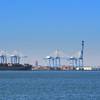According to a report in the Virginian Pilot, the North American head of shipping conglomerate A.P. Moller-Maersk Group called for increased investment in U.S. ports and said planning is already under way for the second phase of the new terminal his company is building in Portsmouth, Va.
James R. Bruner, president and chief executive officer of Maersk Inc., said North American ports need to vastly increase their capacity to handle a flood of cargo containers expected from Asia in coming years. He spoke Thursday evening at the annual banquet of the Virginia Maritime Association, formerly the Hampton Roads Maritime Association, at the Norfolk Marriott Waterside and Waterside Convention Center.
The number of containers moving to and from North America grew 13 percent last year, he said. That pace is unlikely to ease, he said, with the growth of manufacturing in China, India and the rest of Asia in the past decade.
Already, the equivalent of 16 million 20-foot-long shipping containers is being imported to North America, while 7.8 million are exported, he said. The 20-foot unit is the standardized maritime industry measurement for cargo containers, which exist in 20-, 40- and 53-foot lengths.
Without expansion, many ports will hit capacity limits by 2010, Bruner said. Also , 58 percent of the ships being built won't be able to call on many East Coast ports, he said, because the harbors are not deep enough to handle those megafreighters, some with the capacity to carry more than 10,000 containers apiece.
Only a few new North American terminals are planned, he said. One of those is the 291-acre facility Maersk's APM Terminals unit is expected to open in Portsmouth in July 2007.
To help reduce the terminal's impact, all terminal equipment will be powered by electricity, rather than the traditional diesel, he said.
The first phase of the terminal will open next year, covering 230 acres and 3,200 feet of wharf.
Planning has begun on the second phase, Bruner said. That will add 60 acres and 800 feet of wharf, doubling its capacity to 2 million 20-foot-equivalent containers.
Source: Virginian Pilot
Featured videos

Tracking Foreign Vessels Working in the U.S. Jones Act Market

Inside the Electrified Truckable Tug

Inmarsat Enhances Service to Drive Digitalization
Subscribe for
Maritime Reporter E-News
Maritime Reporter E-News is the maritime industry's largest circulation and most authoritative ENews Service, delivered to your Email five times per week









